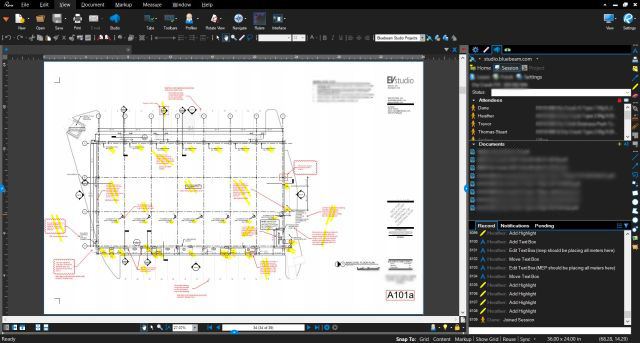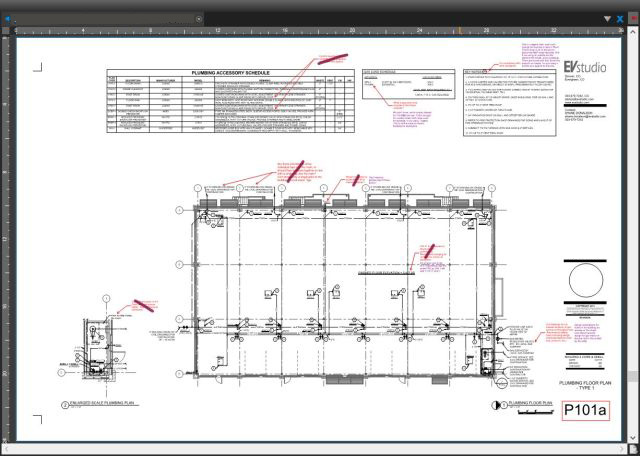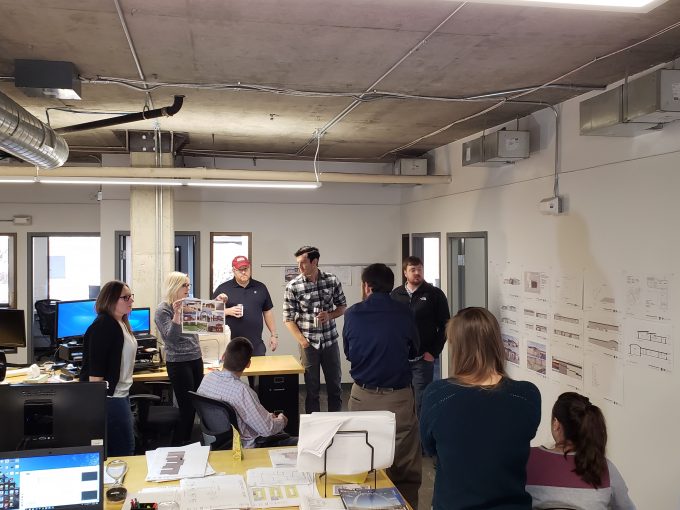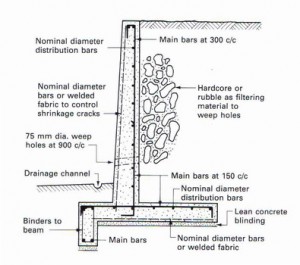
EVstudio has established a rigorous process for Internal Technical Review (ITR) of all projects before issuing any documents for permitting and construction. In addition to our Quality Assurance process involving checklists and assigned responsibilities during design and production, the ITR process ensures consistent Quality Control of the final deliverables.
As a multi-disciplinary design firm EVstudio has a broad range of contract types including from one to as many as seven disciplines on any given project, plus optional Construction Observation services. Each discipline performs separate reviews of their design and documents and relevant coordination with other disciplines to get the drawings as close to 100% as possible before they are then passed on to a primary reviewer for full ITR of all combined disciplines. This primary reviewer is typically the architect or engineer who will be stamping the drawings, or a dual-licensed architect/engineer.
Using an all-digital process, the reviewer performs a methodical check of the documents for each discipline and how they all coordinate with each other to deliver the intent of the project that has been determined with the client during the design process. This all-digital process involves cloud-based, real-time collaboration for all team members, providing efficiency to the process by allowing team members to access it from any location and respond to reviewer’s questions and revisions during the review.


The reviewer focuses on code compliance and building technology but also on constructability and how well the documents will convey the design intent to a contractor, sub-contractor or tradesperson in the field. The reviewed documents are then reviewed and coordinated with the design team in person and revised by each discipline’s original designer and/or production staff to close the internal feedback loop. This informs the team of the reviewer’s insights so that the pre-ITR quality of future CD’s can be improved.
Then the process is repeated until the primary reviewer is satisfied that all ITR comments have been properly addressed. If the primary reviewer is not the professional stamping the drawings, then the stamping architect or engineer reviews the final documents and all the ITR comments to confirm that the project conforms to their expectations before sealing the drawings and issuing them.
Typically this process requires at least two weeks for most projects involving new construction or extensive remodeling of a whole building. For smaller Tenant Improvement or addition projects and even some single-family homes it may only require one week, but for large projects and especially projects with multiple buildings it can require three weeks or more.

As the production of Construction Documents (CD’s) nears completion, there is often great pressure to shortcut the ITR process and issue the documents as soon as possible, but there are several reasons that the integrity of the ITR process must be maintained. The quality control provided by the ITR process is beneficial to all parties involved in the design, permitting and construction process.
From the owner’s perspective, the improved quality of the Construction Documents minimizes inaccuracies in bidding and construction that may lead to Change Orders increasing project cost and construction duration. Higher quality documents also minimize Requests for Information (RFI’s) that slow the construction process and require the time of the Contractor, Architect, and Owner, time that can be better spent on other tasks or on greater profitability for each party throughout the project.
From the architect’s perspective more thoroughly coordinated drawings minimize the likelihood of errors and omissions in CD’s, and more complete documents help ensure that the owner and contractor have the fullest possible understanding of the construction work ensuring that expectations are met, and costly changes not needed. In addition, a technical review is expected to be an essential part of any architect or engineer’s professional Standard of Care and should not be compromised.
From the perspective of the Authority Having Jurisdiction (AHJ), higher quality Construction Documents make the plan reviewer’s job easier and faster, requiring fewer comments, and they help ensure that the constructed product is code compliant. This also makes life easier for the AHJ’s inspectors in the field. Fewer comments during the AHJ plan review and fewer flagged items during inspections also save the project time and expense, additional benefits to the owner.
Although gaining time in the CD production and permitting schedule by compromising the technical review process may be tempting, all parties involved in a project should realize that the benefits for each of a full technical review are far more valuable for the project in the long run. For most projects, the time spent on a thorough technical review of the Construction Documents can easily be recovered in saved time later in the schedule. That time saved and fewer construction changes can combine into substantial cost savings to a project.
Make sure your project has a thorough technical review!










